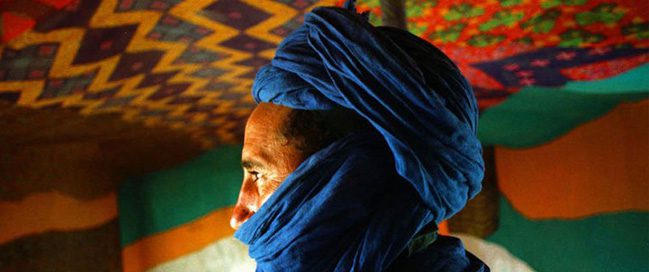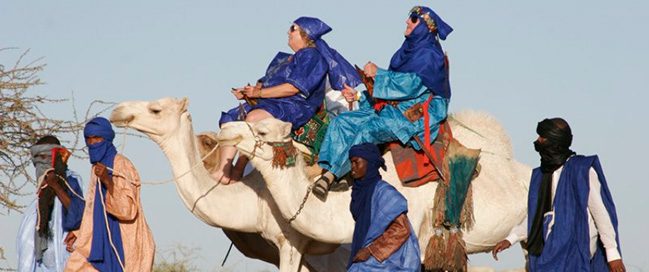
Tribal lifestyle has always been fascinating for people living in urban locations. The life of Sahara nomads such as the Tuareg tribe for instance is much different than the life of city people in many regards.
How does this tribal lifestyle look like then? How does the Tuareg, or the Sahara nomads live?
Early travelers’ stories often referred to them as the Blue Men of the Sahara Desert, the Tuareg men are known for veiling their faces with an indigo cloth. And sadly, that is the extent of many people’s knowledge about the Tuareg.
So let’s dive into the tribal lifestyle here and learn more about the life of the nomads of the Sahara.

The Tuareg are a substantial ethnic population that crosses the boundaries of several countries but have no majority of inhabitants in any specific country. The Tuareg call themselves Imohag, which means free man.
The language of the Tuareg is called Tamacheq, but Tuareg also uses a written script known as Tifinagh.
They lead a semi-nomadic life across the Sahara Desert, in the North African countries of Mali, Niger, Libya, Algeria, and Chad. Semi-nomadic means that they traveled a lot but they also had homes and lands in which they grew some crops.
In the old days, Tuareg society was divided between those who tended the land and those who did not, plowing the land being the work of lower classes, while the upper classes worked in trading.
However, that changed over time as trading was off the table.

Part of the Berber group of people, the Tuareg have lived in extreme living conditions in the heart of the Sahara for over a thousand years.
The Tuareg first crossed roads with modern civilization at the beginning of the fourteenth century, when trade routes to the profitable salt, gold, and ivory markets between North Africa, Europe, and the Middle East sprang up across Tuareg territory. The Tuareg began to work in trading and utterly controlled these routes because of their extensive knowledge of the Sahara.
After the establishment of nation-states in the region in the early 1960s, Governments started to impose restrictions on trade with neighboring countries in order to protect national economic interests. As a result, the Tuareg started to lose economic strength and political power.

The most famous aspect of the Tuareg men and the most mysterious one is the blue veil.
Tuareg men begin wearing a veil at the age of 25. This blue veil conceals their entire face except for their eyes. It is almost never removed, even in front of family members.
It is commonly believed that men began wearing the veil to protect their faces from the Sahara sands. However, why it has gained such significance is unknown, one speculation says that it is because they believe that men should conceal all emotion and show no facial expressions, especially in front of strangers.

The men often write beautiful poems and try to gain the women’s affection in many ways. That is mostly because the end decision rests with the women themselves.
When the woman finally says yes they start preparing for the wedding, which is an elaborate week-long event.
When a woman gets married, her female family members usually give her a tent as a dowry. The bride often keeps that tent during her lifetime. The Tuareg believe that the house belongs to the woman.
The woman also owns the family’s livestock. That might be because the men travel a lot. And because they travel a lot, men highly value their camels and swords, they consider them their most valuable positions.

Tuareg mostly live in tents. They make these tent-like homes by setting up wooden posts and then covering the posts with cloth or fabric. And to help cool down these houses and to keep the desert sand from getting inside, they put straw mats on the inside of the cloth walls.
The Tuareg believe in educating all the members of their tribe. All the little kids are taught how to read and also taught the teachings of the Quran.
Tuareg Tribe is one of the few matrilineal tribes around the world; this means that family lines are traced through women rather than men.
One of the significant sources of income for the Tuareg is selling their art and handicrafts. This art is mostly in the form of jewelry, leather, and metal saddle decorations, as well as beautifully crafted weapons, which include two-edged swords, sheathed daggers, iron lances, and leather shields.

The Tuareg do not eat meat often. They are not vegetarians, it is just that livestock is too precious. They only eat meat on special occasions like festivals and weddings.
They substitute it with eating a lot of non-meat protein, such as milk and cheese. Their diet features a lot of dates and melon as well.
Sometimes on special occasions, they consume a nice beverage called Eghajira, which is created by pounded millet, dates, and cheese mixed water.
Tuareg holds an annual event called Festival de l’Aïr. This festival celebrates Tuareg culture through dance, poetry, and music. Only working men participate in dancing ceremonies, Tuareg women do not dance in front of strangers and noblemen do not dance, out of the fear of looking undignified.
Tuareg music has gained some international attention through The ‘desert rock’ music scene, especially bands like Tinariwen and Tamikrest.
Best Carnivals Around the World: Learn about countries’ cultures